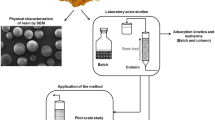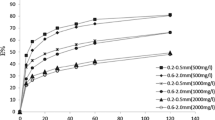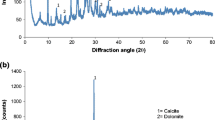Abstract
Ammonium removal from drinking water to protect human and environmental health is one of the major global concerns. This study evaluates the performance of Purolite C100E, a commercial cation exchange resin, in eliminating ammonium in synthetic and real contaminated groundwater. The results demonstrate that the pH operation range of the resin for better ammonium removal is 3 to 8. Lower ammonium removal at low and high pH occurred due to competition from H+ and loss of ammonium as ammonia gas, respectively. Equilibrium data of ammonium removal fitted both the Langmuir and Freundlich isotherm models with the maximum Langmuir ion exchange capacities for initial ammonium concentrations of 10–200 mg/L and 50–2000 mg/L, reaching 18.37 mg/g and 40.16 mg/g, respectively. The presence of co-ions in the water reduced the ammonium removal efficiencies slightly (< 12%) in the order Mg2+ > Ca2+ > K+. The higher affinity of ammonium to adsorbent is due to its lower hydrated ionic radius and H-bonding. The maximum exchange capacity in the fluidized bed studies of the original Purolite C100E (bed height 27 cm, resin weight 75 g, initial ammonium concentration 17.4 mg/L, filtration velocity 0.5 m/h) was 10.48 mg/g. It progressively reduced slightly after three regeneration cycles to 8.79 mg/g. The column breakthrough data satisfactorily fitted the Thomas model. A household filter cartridge packed with 4 kg Purolite C100E (80 cm height) and operated at a filtration velocity of 1.9 m/h in Vietnam successfully reduced the initial 6 mg NH4+/L in groundwater (after sand filter pre-treatment) to well below the Vietnam drinking water standard (3 mg/L-QCVN 01:2009/BYT) continuously for 1 week, suggesting that such a filter can be adopted in rural areas to successfully remove ammonium from groundwater.









Similar content being viewed by others
Data availability
The datasets used and analyzed during the current study are available from the corresponding author on reasonable request.
References
Aliewi A, Al-Khatib IA (2015) Hazard and risk assessment of pollution on the groundwater resources and residents’ health of Salfit District. Palestine J Hydrol Reg Stud 4:472–486
Alshameri A, Ibrahim A, Assabri AM, Lei X, Wang H, Yan C (2014) The investigation into the ammonium removal performance of Yemeni natural zeolite: modification, ion exchange mechanism, and thermodynamics. Powder Technol 258:20–31
Aral N, Günay A, Sevimoǧlu O, Çali M, Debik E (1999) Ammonia removal from aqueous solution by ion exchange using natural zeolite. Fresenius Environ Bull 8:344–349
Demir S, Top H, Balkose A, Ülkü D (2008) Dye adsorption behavior of Luffa cylindrica fibers. J Hazard Mater 153:389–394
Ding Y, Sartaj M (2016) Optimization of ammonia removal by ion-exchange resin using response surface methodology. Int J Environ Sci Technol 13:985–994
Freundlich HM (1906) Over the adsorption in solution. J Phy Chem 57:385–470
Halim AA, Latif MT, Ithnin A (2013) Ammonia removal from aqueous solution using organic acid modified activated carbon. World Appl Sci J 24:1–6
Hedström A, Amofah LR (2008) Adsorption and desorption of ammonium by clinoptilolite adsorbent in municipal wastewater treatment systems. J Environ Eng Sci 7:53–61
Huang Y, Du Y, Ma T, Deng Y, Tao Y, Xu Y, Leng Z (2021) Dissolved organic matter characterization in high and low ammonium groundwater of Dongting Plain, central China. Ecotoxicol Environ Saf 208:111779
ISO 7150–1, 1984. Water quality - determination of ammonium – part 1: manual spectrometric method. International Standard.
Jorgensen TC, Weatherley LR (2003) Ammonia removal from wastewater by ion exchange in the presence of organic contaminants. Water Res 37:1723–1728
Kalaruban M, Loganathan P, Shim WG, Kandasamy J, Naidu G, Nguyen TV, Vigneswaran S (2016) Removing nitrate from water using iron-modified Dowex 21K XLT ion exchange resin: batch and fluidised-bed adsorption studies. Sep Purif Technol 158:62–70
Khalil A, Sergeevich N, Borisova V (2018) Removal of ammonium from fish farms by biochar obtained from rice straw: isotherm and kinetic studies for ammonium adsorption. Adsorpt Sci Technol 36:1294–1309
Kumar KV, Sivanesan S (2006) Selection of optimum sorption kinetics: comparison of linear and non-linear method. J Hazard Mater 134:277–279
Langmuir I (1918) The adsorption of gases on plane surfaces of glass, mica and platinum. J Am Chem Soc 40:1361–1403
Li K, Zheng Z, Huang X, Zhao G, Feng J, Zhang J (2009) Equilibrium, kinetic and thermodynamic studies on the adsorption of 2-nitroaniline onto activated carbon prepared from cotton stalk fibre. J Hazard Mater 166:213–220
Mashal A, Abu-Dahrieh J, Ahmed AA, Oyedele L, Haimour N, Al-Haj-Ali A, Rooney D (2014) Fixed-bed study of ammonia removal from aqueous solutions using natural zeolite. World J Sci Technol Sustain Dev 11:144–158
Nguyen TT, Kawamura A, Tong TN, Nakagawa N, Amaguchi H, Gilbuena R (2014) Hydrogeochemical characteristics of groundwater from the two main aquifers in the Red River Delta. Vietnam J Asian Earth Sci 93:180–192
Nguyen TTQ, Loganathan P, Nguyen TV, Vigneswaran S, Ngo HH (2020) Iron and zirconium modified luffa fibre as an effective bioadsorbent to remove arsenic from drinking water. Chemosphere 258:127370
Nguyen VA, Bang S, Viet PH, Kim KW (2009) Contamination of groundwater and risk assessment for arsenic exposure in Ha Nam province. Vietnam. Environ Int 35:466–472
Nitzsche KS, Lan VM, Trang PTK, Viet PH, Berg M, Voegelin A, Friedrich BP, Zahoransky J, Muller SK, Byrne JM, Schroder C, Behrens S, Kappler A (2015) Arsenic removal from drinking water by a household sand filter in Vietnam - effect of filter usage practices on arsenic removal efficiency and microbiological water quality. Sci Total Environ 502:526–536
Norrman J, Sparrenbom CJ, Berg M, Dang DN, Jacks G, Harms-Ringdahl P, Pham QN, Rosqvist H (2015) Tracing sources of ammonium in groundwater in a well field in Hanoi (Vietnam) by means of stable nitrogen isotope values. Appl Geochemistry 61:248–258
Nur T, Johir MAH, Loganathan P, Nguyen T, Vigneswaran S, Kandasamy J (2014) Phosphate removal from water using an iron oxide impregnated strong base anion exchange resin. J Ind Eng Chem 20:1301–1307
Purolite Co., 2013. Purolite Engineering Bulletin. (accessed in August 2021) https://www.purolite.com/dam/jcr:c3ab3898-f067-474c-9e45-03c53324ec6d/C100 Sodium Cycle.pdf.
Rusmin R, Sarkar B, Liu Y, Mcclure S, Naidu R (2015) Applied Surface Science Structural evolution of chitosan – palygorskite composites and removal of aqueous lead by composite beads. Appl Surf Sci 353:363–375
Rusydi AF, Onodera S-I, Saito M, Hyodo F, Maeda M, Sugianti K, Wibawa S (2021) Potential sources of ammonium nitrogen in the coastal groundwater determined from a combined analyses of nitrogen isotope, biological and geological parameters and land use. Water 13:25
Qiang A, Zheng L, Ying Z, Fanyu M, Bin Z, Yue M, Shuman D (2021) Ammonium removal from groundwater using peanut shell based modified biochar: mechanism analysis and column experiments. J Water Process Eng 43:102219
Sabogal-Paz LP, Campos LC, Bogush A, Canales M (2020) Household slow sand filters in intermittent and continuous flows to treat water containing low mineral ion concentrations and bisphenol. A Sci Total Environ 702:135078
Shaw GD, White ES, Gammons CH (2013) Characterizing groundwater-lake interactions and its impact on lake water quality. J Hydrol 492:69–78
Sica M, Duta A, Teodosiu C, Draghici C (2014) Thermodynamic and kinetic study on ammonium removal from a synthetic water solution using ion exchange resin. Clean Technol Environ Policy 16:351–359
Tanabe K, Yokota H, Hironaka H, Tsushima S, Kubota Y (2001) Arsenic pollution of groundwater in Bangladesh. Appl Organomet Chem 15:241–251
Tchobanoglous G, Stensel HD, Tsuchihashi R, Burton F (2014) Metcalf and Eddy | AECOM-Wastewater engineering treatment and resource recovery, 5th edn. McGraw-Hill, New York
Terin UC, Sabogal-Paz LP (2019) Microcystis aeruginosa and microcystin-LR removal by household slow sand filters operating in continuous and intermittent flows. Water Res 150:29–39
Thomas HC (1944) Heterogeneous ion exchange in a flowing system. J Am Chem Soc 66:1664–1666
Tseng JY, Chang CY, Chang CF, Chen YH, Chang CC, Ji DR, Chiu CY, Chiang PC (2009) Kinetics and equilibrium of desorption removal of copper from magnetic polymer adsorbent. J Hazard Mater 171:370–377
Vietnam Environment Agency, 2016. Vietnam’s National Environment Report 2011 – 2015. Hanoi, Vietnam.
Vietnamese Department of Preventive Medicine & Environment, 2009. QCVN 01:2009/BYT: national technical regulation on drinking water quality. Hanoi, Vietnam.
Volkov AG, Paula S, Deamer DW (1997) Two mechanisms of permeation of small neutral molecules and hydrated ions across phospholipid bilayers. Bioelectrochem Bioenerg 42:153–160
Vu TM, Trinh VT, Doan DP, Van HT, Nguyen TV, Vigneswaran S, Ngo HH (2017) Removing ammonium from water using modified corncob-biochar. Sci Total Environ 579:612–619
Vu TM, Chao H-P, Trinh VT, Le TT, Lin C-C, Tran HN (2018) Removal of ammonium from groundwater using NaOH-treated activated carbon derived from corncob wastes: batch and column experiments. J Clean Prod 180:560–570
Wang YF, Lin F, Pang WQ (2007) Ammonium exchange in aqueous solution using Chinese natural clinoptilolite and modified zeolite. J Hazard Mater 142:160–164
Wassie AB, Srivastava VC (2016) Teff straw characterization and utilization for chromium removal from wastewater: kinetics, isotherm and thermodynamic modelling. J Environ Chem Eng 4:1117–1125
Funding
This study was financially supported by the Aus4Innovation program — a development cooperation initiative funded by the Australian Department of Foreign Affairs and Trade and InnovationXchange. It is managed by the Commonwealth Scientific and Industrial Research Organization, in partnership with the Ministry of Science and Technology of Vietnam.
Author information
Authors and Affiliations
Contributions
• Conceptualization: Tien Vinh Nguyen.
• Methodology: Paripurnanda Loganathan, Le Minh Tran, Tien Vinh Nguyen
• Formal analysis and investigation: Dai Quyet Truong
• Writing — original draft preparation: Dai Quyet Truong
• Writing — review and editing: Paripurnanda Loganathan, Le Minh Tran, Duc Loi Vu, Tien Vinh Nguyen, Saravanamuthu Vigneswaran, Gayathri Naidu
• Funding acquisition: Tien Vinh Nguyen, Saravanamuthu Vigneswaran
• Resources: Le Minh Tran, Duc Loi Vu, Tien Vinh Nguyen, Saravanamuthu Vigneswaran
• Supervision: Le Minh Tran, Tien Vinh Nguyen
Corresponding author
Ethics declarations
Ethics approval and consent to participate
Not applicable.
Consent for publication
Not applicable.
Competing interests
The authors declare no competing interests.
Additional information
Responsible Editor: Tito Roberto Cadaval Jr
Publisher's Note
Springer Nature remains neutral with regard to jurisdictional claims in published maps and institutional affiliations.
Rights and permissions
About this article
Cite this article
Truong, D.Q., Loganathan, P., Tran, L.M. et al. Removing ammonium from contaminated water using Purolite C100E: batch, column, and household filter studies. Environ Sci Pollut Res 29, 16959–16972 (2022). https://doi.org/10.1007/s11356-021-16945-1
Received:
Accepted:
Published:
Issue Date:
DOI: https://doi.org/10.1007/s11356-021-16945-1




